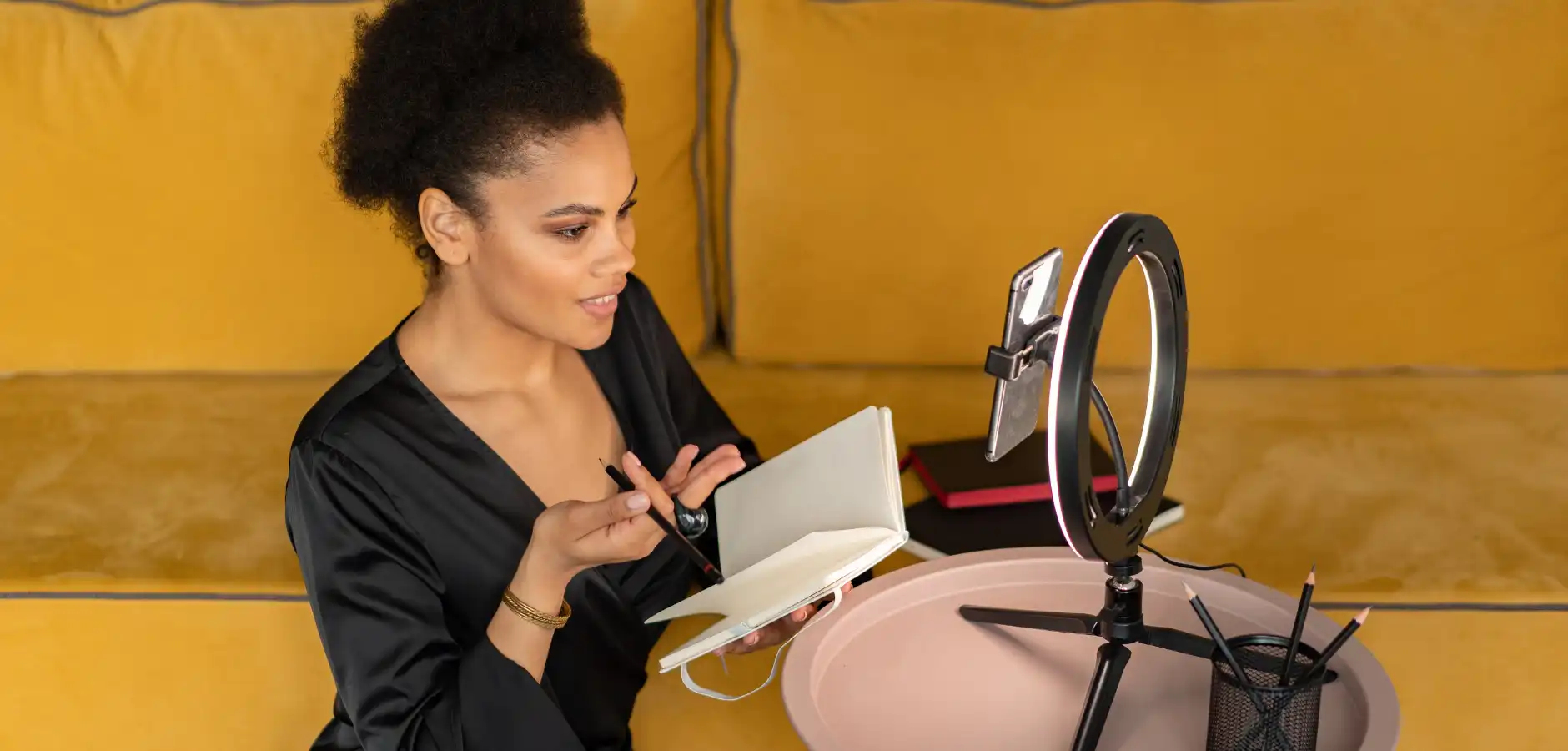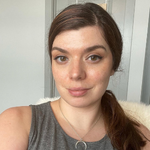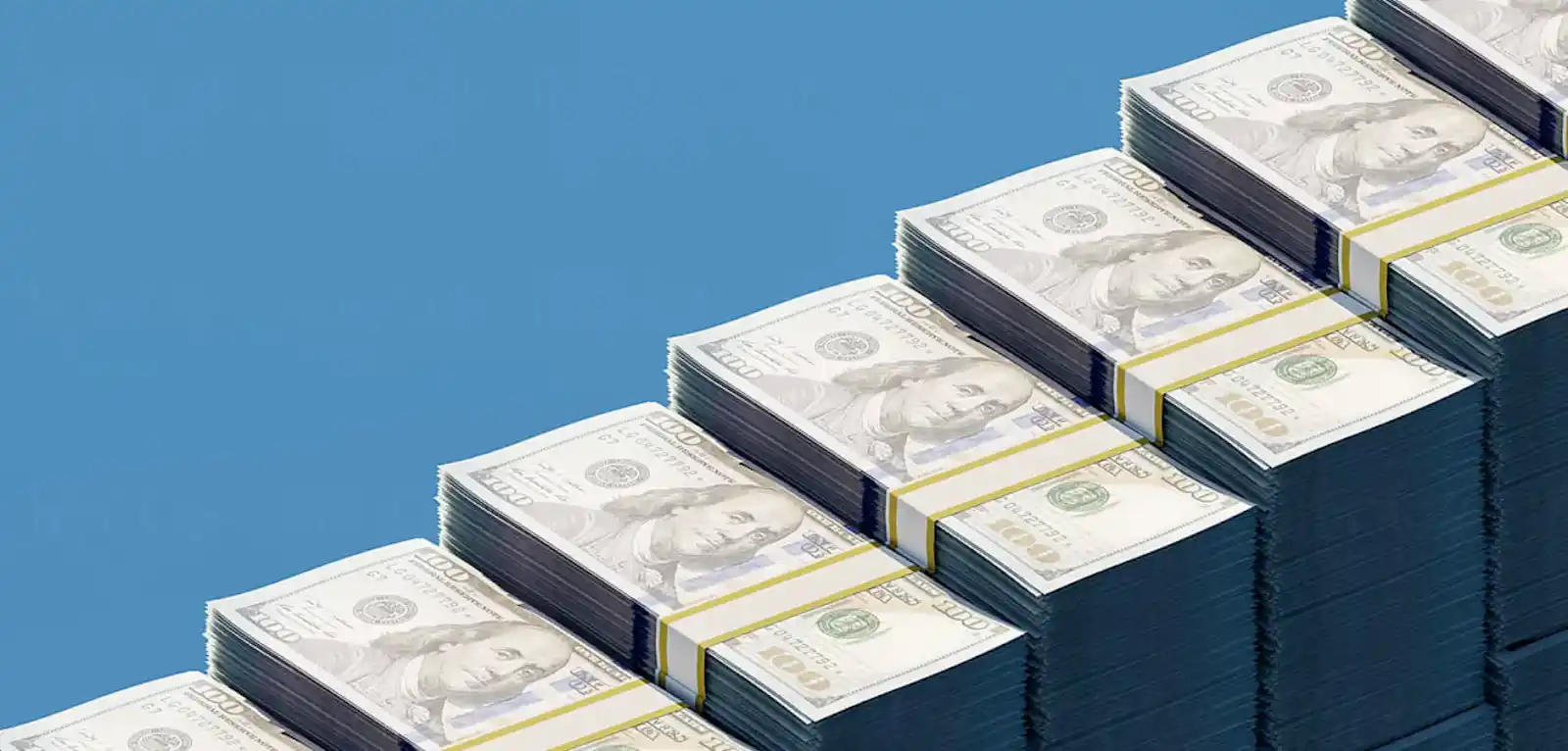Content creators are more vital to brands’ marketing strategies than ever. In 2024, two out of every three brands will expand their creator programs. Some brands are even hiring creators as full-time employees.
But can you get brand deals as a small influencer?
Absolutely! It’s natural to think you might not have enough audience to partner with brands, but don’t underestimate yourself.
Sixty-nine percent of brands reported that they plan to use primarily nano- or micro-influencers.
Being a small influencer isn’t a weakness—it might be exactly what a brand is looking for.
Here’s how to get collabs with a niche audience—and get brands to come to you.
Index
- 5 reasons why brands want to work with small influencers
- 5 steps to get brand deals as a small influencer
- Make your brand deals a success
5 Reasons why brands want to work with small influencers
Nano-influencers (creators with less than 15,000 followers) and micro-influencers (with 15,000 to 75,000 followers) can better help brands reach their goals than influencers with massive audiences, making you an indispensable partner.
1. You have a niche audience
Macro-influencers attract followers with diverse demographics and interests—it’s harder for a brand to resonate with a large portion of that creator’s audience.
As a nano- or micro-creator, your specific niche earns your audience’s trust. So, when you partner with the right brand, your recommendations are highly relevant to your followers.
2. You tend to have higher engagement and conversions
Micro-influencers tend to have higher engagement and conversion rates than macro-influencers, though it depends on the platform.
A smaller following fosters a more personal connection. So your audience is more invested in your content, and the quality of every “like” and comment is higher.
On her podcast, Creator Club, YouTuber Katie Steckly explains, “If you have 100,000 followers, but not a single one of them will click on the links in your Instagram Story, it doesn’t really mean anything. You’re much better off having 1,000 followers that actually care what you have to say and really trust your opinion—and brands feel that way too.”
Because your audience trusts you more, they’re more likely to pay attention to your suggestions.
That means brands get more value from the partnership when they work with you.
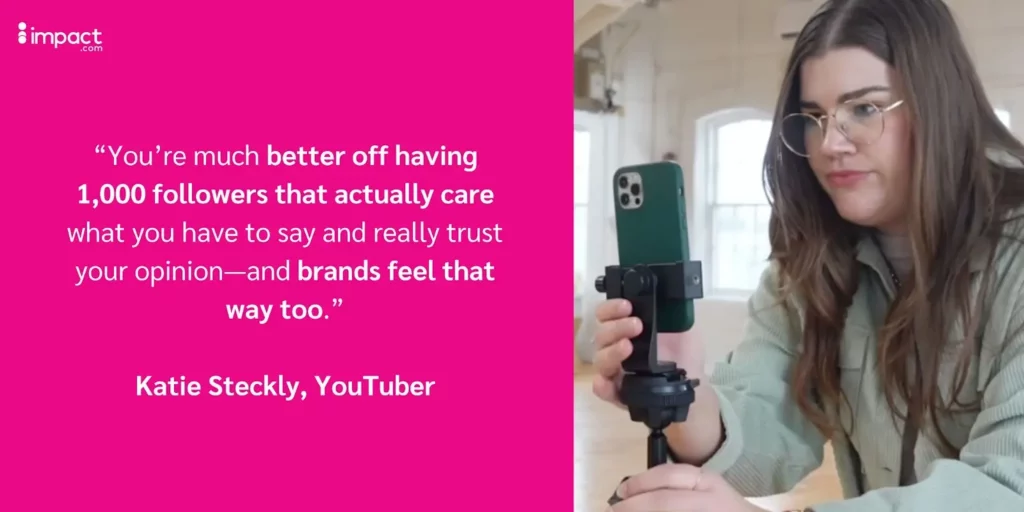
Sources: Creator Club Podcast, Become a full-time creator before the end of the year video
3. You’re more relatable
People want to see themselves in the creators they follow.
This is how Emma Chamberlain began her journey on YouTube—living an everyday teenage life vlogging from her bedroom. Her followers loved her effortless authenticity and approachable content.
But as she rose to stardom, she started regularly appearing on red carpets and magazine covers. Her new LA home, complete with artisan furnishings and fixtures that cost tens of thousands of dollars, was featured in Architectural Digest.
Today, many of her once devoted fans now find her “unrelatable.”
The moral of the story: nano- and micro-creators are often way more relatable than creators who live glamorous, unattainable lives for the everyday person.
Your life and expertise resonate with your followers, building trust and credibility. This makes them naturally more likely to buy based on your recommendations—and makes you more valuable to brands.
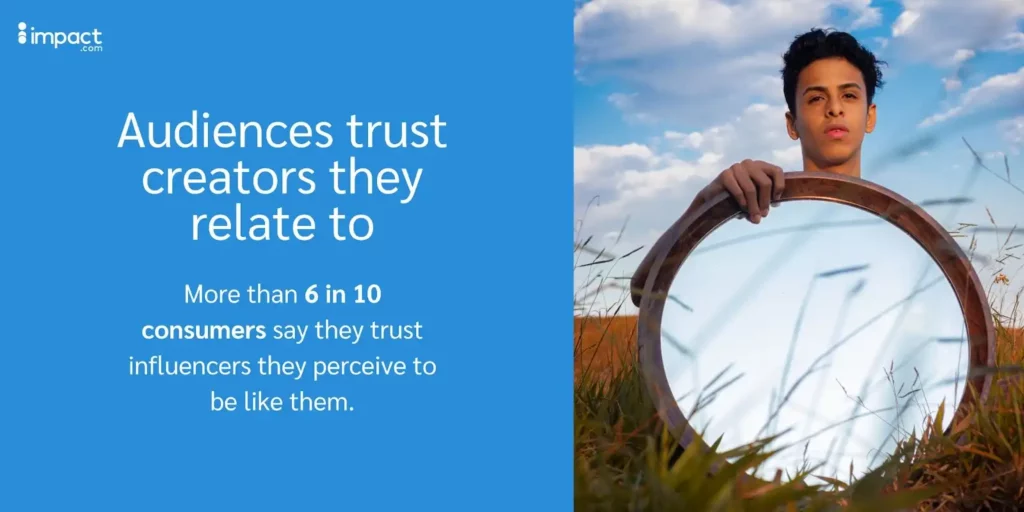
Source: The state of influencer marketing for consumers in 2023
4. You become integrated into the team
Macro- and mega-influencers often juggle dozens of partnerships at once, so they may not be as invested in each brand collab.
As a small influencer, you can cultivate a closer relationship with a brand and become an extension of their marketing team.
This gives you a greater ability to tailor your content to the brand’s goals—and this collaborative spirit can appeal to brands seeking a more involved partnership.

Source: What brands want: building successful creator partnerships in 2023
5. You fit a brand’s budget
Affordability also makes small influencers an attractive option for brands.
Macro-influencers can cost an estimated $3,000 or more per post. That makes it hard for brands to test out an individual creator.
Meanwhile, nano- and micro-influencer pricing starts at $25–500, depending on the platform and campaign.
This affordability allows brands to test the waters and invest more money when they feel confident you’re a good fit.
5 steps to snagging brand deals as a small influencer
Ready to show brands your true value? Follow these five steps to set yourself up for success.
1. Prime your online presence for partnerships
The first step to landing brand deals is to take yourself seriously. Treat partnerships as part of your business.
Brands look for certain qualities in the creators based on their values, target audience, and campaign goals. Before delving into the brands to collab with and how to approach them, you want to boost your chances of success.
It’s all about building a solid foundation and showing brands what you bring to the table.
Ensure you’re creating content consistently
Consistent posting grows your following and boosts engagement. It’s like sending a message to brands that says, “Hey, I’m serious about what I do!
It also helps you establish a strong personal brand by highlighting what makes you unique. This will attract brands that align with your style and audience.
To post more regularly:
- Create a content calendar to make delivering your promises to brands easy. A simple spreadsheet or project management app will work. If you need somewhere to start, check out our guide on how to create an editorial calendar.
- Make a space to write down content ideas for brand partnerships and your general content. Then you don’t rely on inspiration to strike—and you can hang on to all those genius ideas you think of in the shower.
- Schedule content in advance using platforms such as Buffer and Hootsuite. Batching your work lets you take time to focus on other aspects of your business—such as researching and pitching brands! Simply create multiple pieces of content at a time and use scheduling tools to publish them later.
As you post, prioritize being authentic and transparent with your audience. You want your audience to trust you and your recommendations. Ultimately, this will make your future brand deals more successful, too.
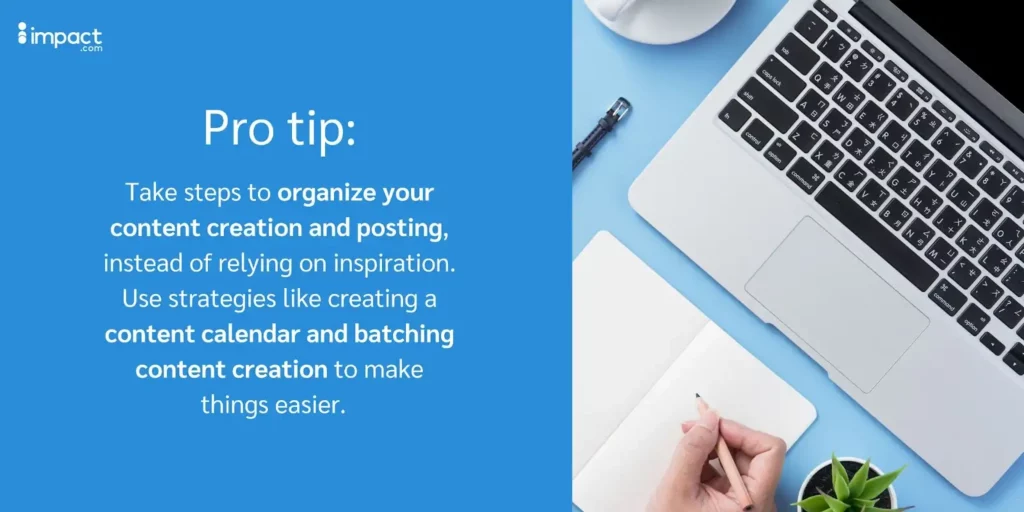
Make yourself as discoverable as possible
According to research, only 5 percent of brands want to source and recruit the creators they want to work with. But it’s also important to make it easy for brands to find you.
Use platform-specific SEO tactics to create more discoverable content. For example, put relevant keywords in your YouTube video or Pinterest pin title, hashtags on Instagram and TikTok, etc.
Katie Steckly of the Creator Club podcast recommends adding the topics you care about to your social media profile description, too.
“You want to use keywords on your profiles that describe who you are—but also who your audience is. A really great way to go about this is to have something like, “I help X people do X, Y, and Z.”
And take advantage of trending topics in your niche. That will make you more discoverable to brands and audiences alike.
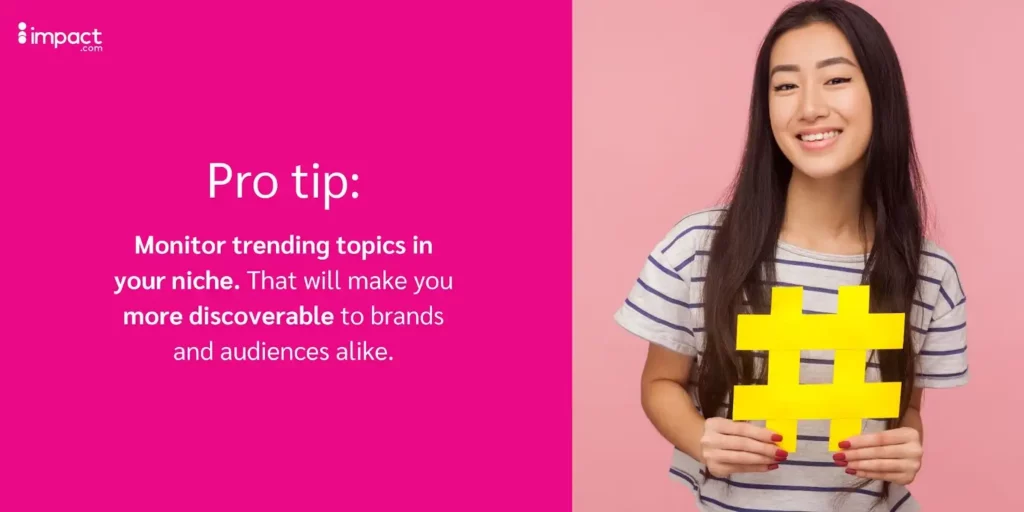
2. Research best-fit brands to work with
When it comes to working with brands, the possibilities are endless. So, get creative with how you approach brand deals.
Kickstart your journey with these tried-and-true techniques:
Think about the brands you (and similar creators) already use
You probably already mention products in your content naturally. Compile a list of products you’d be excited to share with your audience.
83 percent of brands see a deep love and understanding of the brand as indicative of a successful partnership. So, landing a deal is easier when you go after a brand you’re already familiar with.
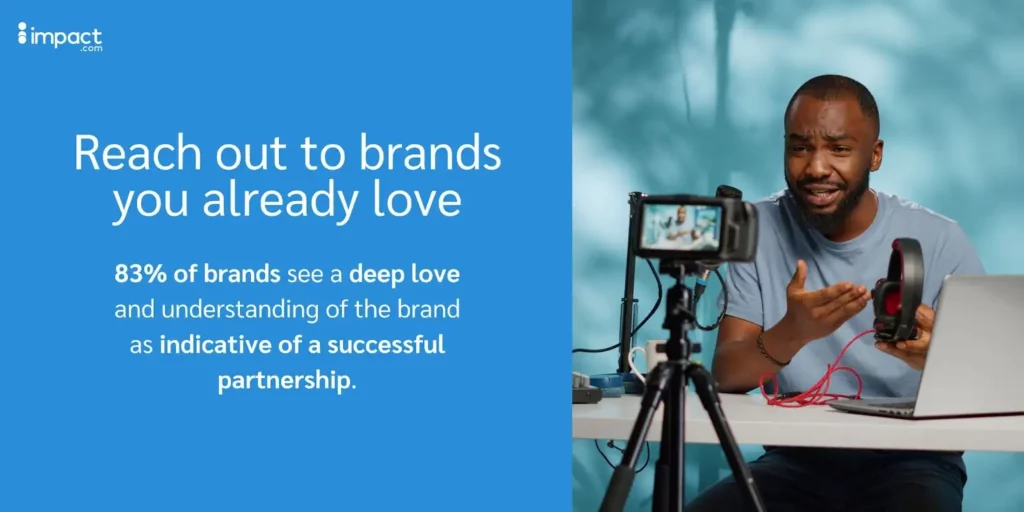
Source: What brands want: building successful creator partnerships in 2023
Also, look at content creators in your niche with a similar follower count. What brands do they use? What sponsorships do they have?
You could even ask for an introduction to their contact. Then, you don’t have to jump through hoops to find the right person.
Look for smaller brands with less competition
Focus on smaller brands to start landing deals more quickly. You’re less likely to get lost in a sea of influencers trying to get the attention of bigger brands.
Don’t waste time on unpaid campaigns with brands with small followings and little engagement. Instead, prioritize collabs that offer value and support your career growth.

Source: What brands want: building successful creator partnerships in 2023
Consider brands outside of your niche
You don’t have to stick to brands in your niche to stay on brand. You can also partner with brands with similar values to yours and your audience’s.

For example, thrift shopping creator Tyler Chanel partnered with How Life Unfolds, a sustainability campaign by the Paper & Packaging Board. While not related to thrifting, the campaign suits Tyler and her followers’ shared value of sustainability.
Sign up for a partnership platform with a marketplace
One of the best ways to find partners is to join an influencer platform with a marketplace that helps connect brands and creators.
Signing up for impact.com / Creator enables you to discover new brands looking to expand their influencer programs—and you get a direct line of contact to pitch proposals. No need to hunt down email addresses or hope a brand sees your DM.
At impact.com, you get payment flexibility—whether your partners pay you at a flat rate or with performance- or commission-based fees. So you can craft a partnership that works best for both of you.
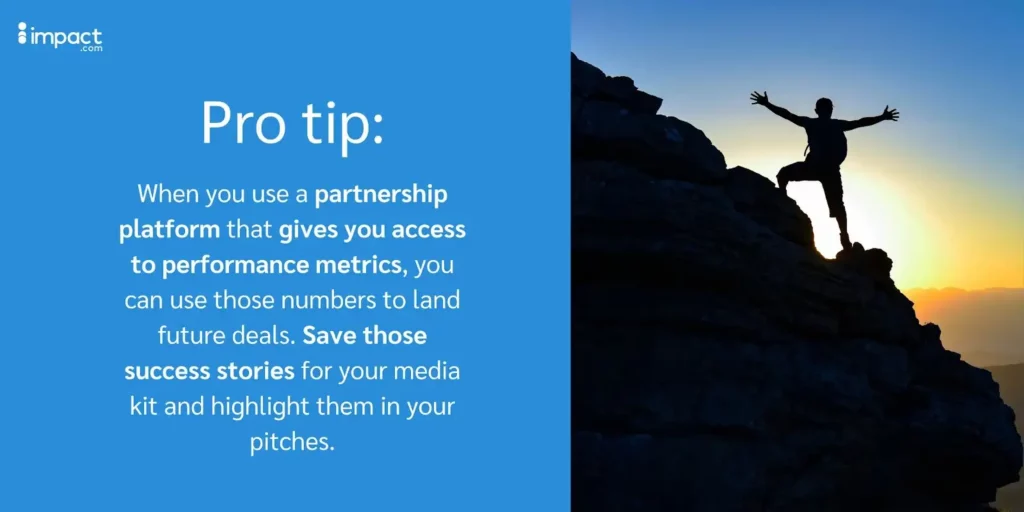
Network with events and online communities
Form bonds with brands and fellow creators by joining online communities or attending industry events.
You can learn effective tactics for forging partnerships, better understand what brands look for, and discover new potential partners.
For example, Buffer’s Discord community has dedicated channels where social managers and creators can chat in more detail. Also, you can meet other content creators and brands at impact.com’s in-person events.
Look into brands offering low-barrier-to-entry partnerships
Ambassador and affiliate programs often have a lower barrier to entry than sponsored posts.
You don’t need a lot of followers to be a good brand ambassador. Instead, brands look for enthusiasm for your niche and how you align with their values. It’s a long-term partnership that brings you loads of experience and opportunities to expand your portfolio.
Becoming an affiliate can also get your feet wet. Simply apply to the brand’s program, generate your affiliate links, and drop them into your posts. There’s no risk to the brands since they only pay commissions based on the sales you refer.
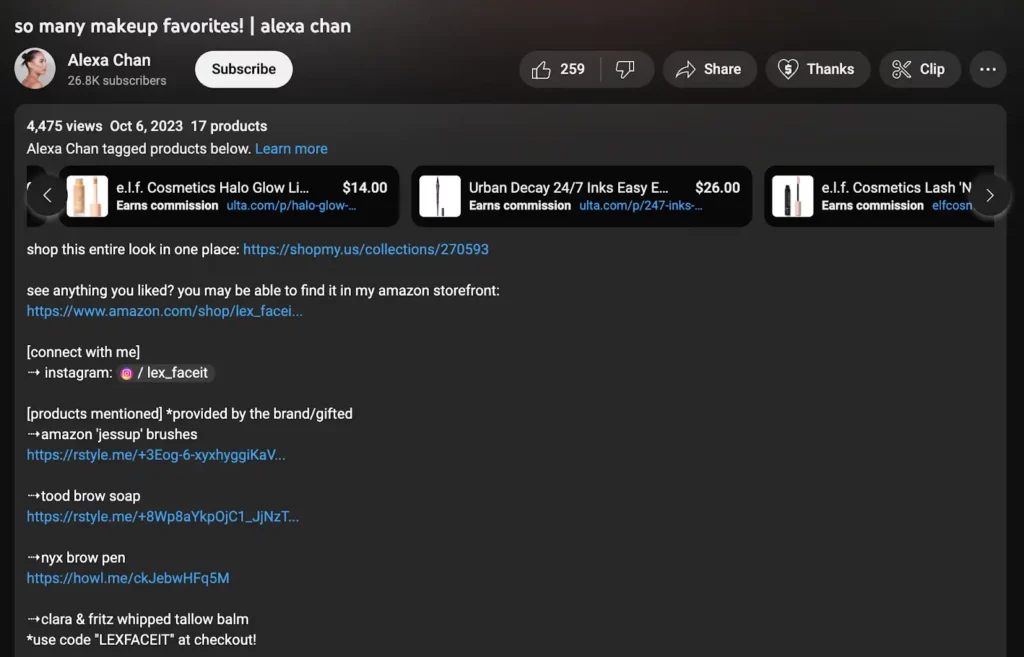
Source: YouTube
Take beauty creator Alexa Chan. She earns affiliate commissions by linking to the products she uses in her YouTube video descriptions. While brands might want to avoid seeing competitors in sponsored content, talking about brands as an affiliate allows Alexa to feature several brands in the same video.
Refer-a-friend programs are even easier to join—any customer can hop on board.
While you may only earn store credit or discounts, this can show brands you can drive sales and set the stage for a deeper partnership.
“This really can get brands’ attention,” says Angela Rollins, former Affiliate Manager at Tortuga, “One of our customers was sending a ton of referrals our way. It turned out he was posting about us on YouTube. So I transferred him to our affiliate program where he could earn real commissions, and we continued our partnership from there.”
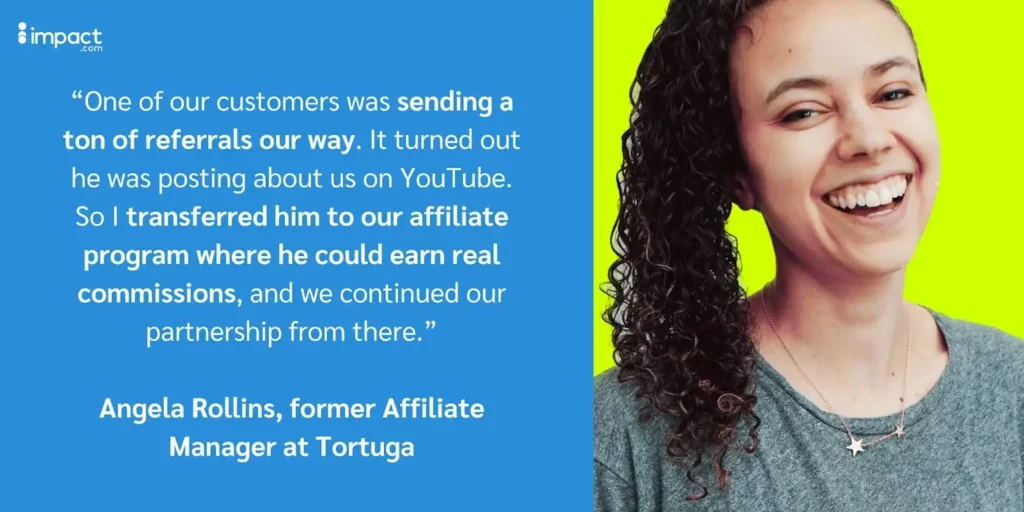
3. Be proactive—brands want you to pitch them
Now that you’ve got potential partners in mind, it’s time to get ready to reach out.
Create a media kit that emphasizes your strengths
Before you start, craft a killer media kit. This should be the brand’s one-stop shop for learning everything about you. Include info about your social media profiles, niche, audience, and the value you bring to the table.
If you don’t have other partnerships to reference, show how your audience engages when discussing products or topics related to the brand. You want to highlight how they can benefit from getting in front of your followers.
You don’t need to build your kit from scratch—use this media kit template!
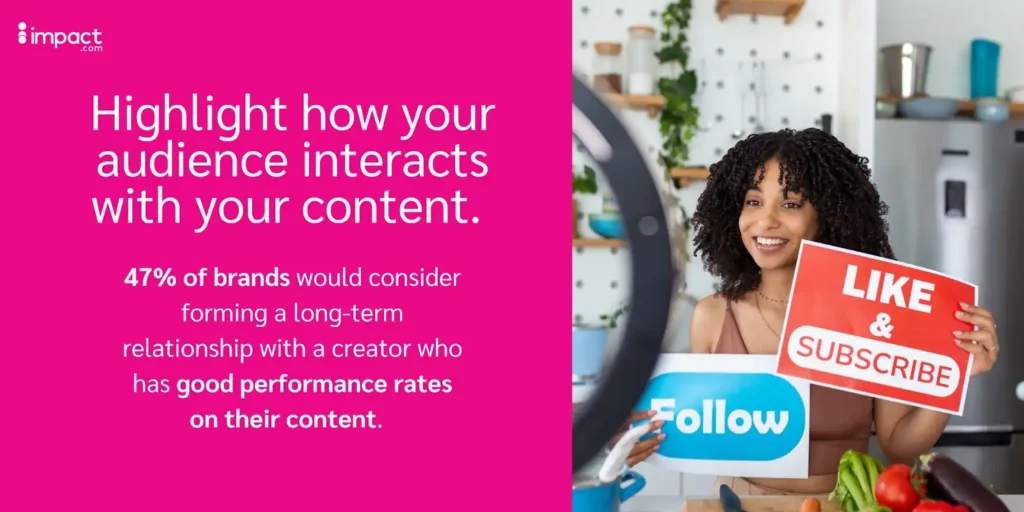
Source: What brands want: building successful creator partnerships in 2023
Build rapport with brands before reaching out
Warm up the connection with brands before you reach out so it doesn’t feel like you came out of nowhere. There are a few ways to make an initial impression.
Create voluntary user-generated content (UGC) featuring products you already use. Voluntary UGC is unpaid content the brand doesn’t request or pay for. If you share it on your socials, the brand will take notice.
UGC also shows brands you can drive engagement and produce high-quality work.
Another way to build rapport? Engage with brands to show you’re a fan. Follow their pages. Like and comment on their posts. Don’t spam, though. Let your engagement feel authentic.
And attend any events the brand puts on. For example, Outdoor Voices puts on pop-ups and workouts at its retail locations. Introduce yourself to the team and let them know you want to work with them.
Make the first move with a tailored pitch email
Now that you’ve planted the seeds for a successful partnership, you’re ready to pitch!
Email is the preferred communication channel for over half of brands—even over DMs. Search for the correct contact on LinkedIn, then use Apollo.io and RocketReach to find email addresses.
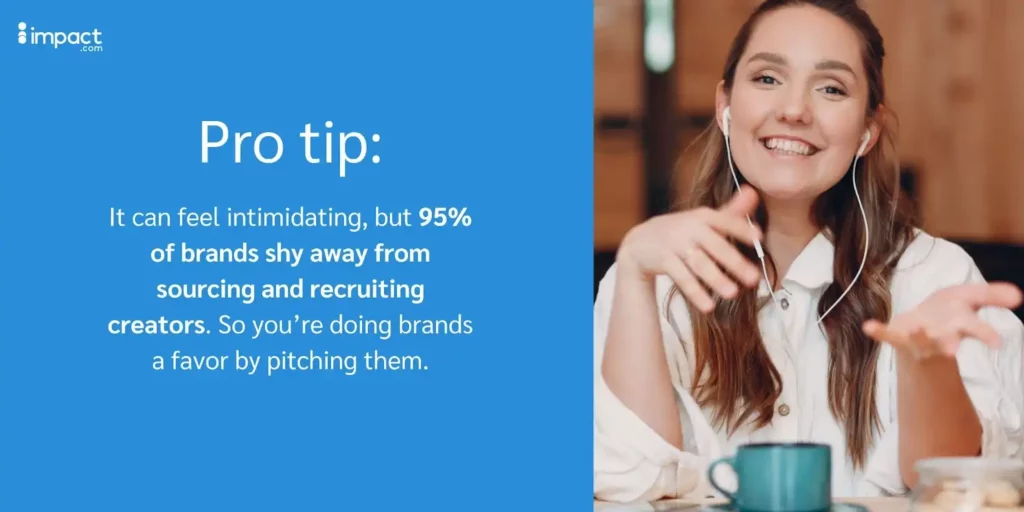
Source: What brands want: building successful creator partnerships in 2023
While creating a pitch email template is helpful, you’ll want to customize it to each brand.
Speak to how your audience matches the brand’s values and ideal demographics and how the products can work with your content style. Propose example campaign ideas so your potential partner can envision how you’ll work together.
Take inspiration from this pitch:

The email’s subject line summarizes the partnership idea. In the body, the creator introduces their niche and how the brand will resonate with their audience.
Get your foot in the door with these alternative brand deals
If you reach out to a brand and discover they have a low budget or no influencer program, there are still ways to collab. And it can be a great way to get your foot in the door and prove your value to the brand.
Consider gifting and seed campaigns. If you have trouble landing brand deals or want to collab with a high-profile brand with no budget, consider taking product gifts or unpaid campaigns. They can give you free products or other benefits such as exposure or a known name for your media kit.
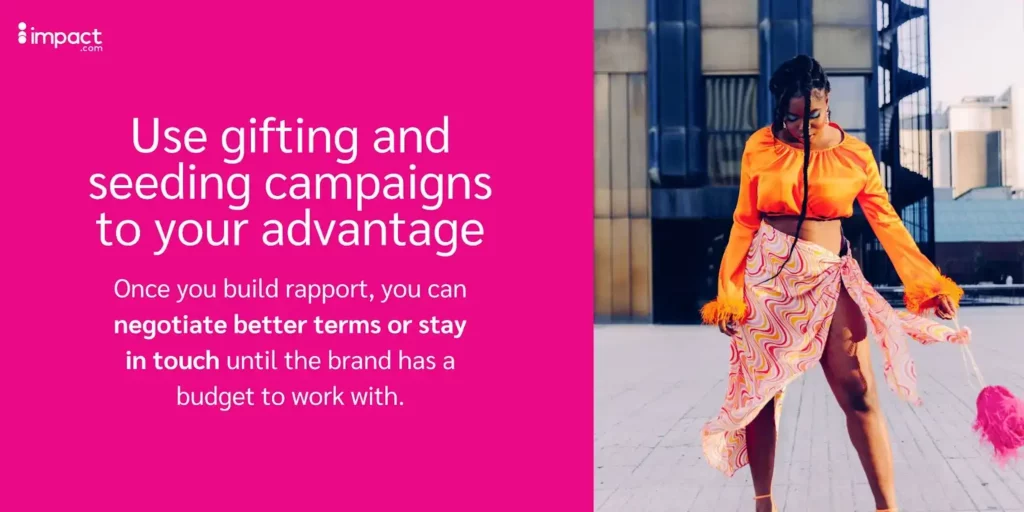
You could also strike a paid UGC deal. Paid UGC means you earn money by creating content for brands they can use on their own marketing channels.
Offering paid UGC allows you to start working with brands that don’t have an influencer marketing program or only work with larger creators. And it gives you the chance to build your experience and portfolio while building a relationship with a brand you love.
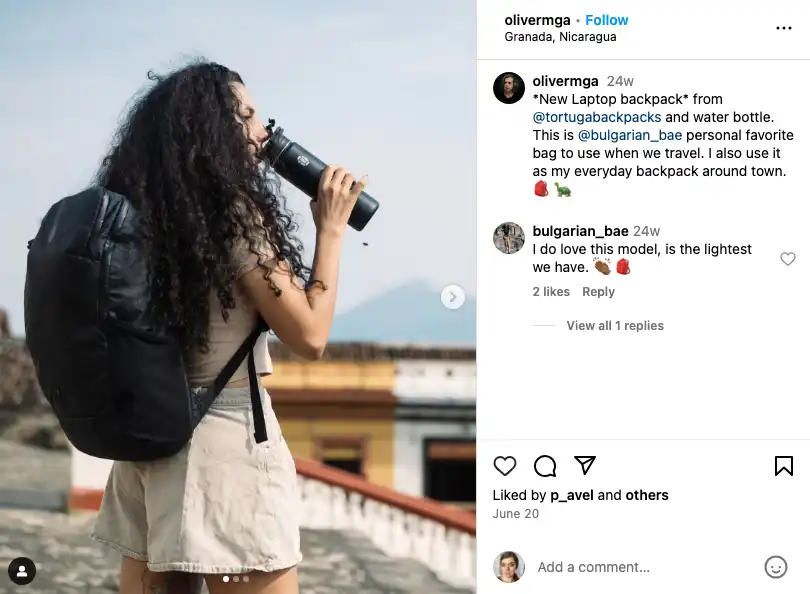
Tortuga’s Traveling Photographers Program develops ongoing partnerships with photographers like Oliver Best (@olivermga) to take pictures of the products in different locations.
4. Negotiate rates carefully and seal the deal with a contract
Make a rate card that you can send to brands interested in partnering. Review how much influencers charge as a starting point.
Include different campaign types and social media platforms depending on what you want to offer (for example, dedicated photo posts, ad reads within a video, brand mentions, etc.). You don’t need to include everything—just enough to start the conversation.
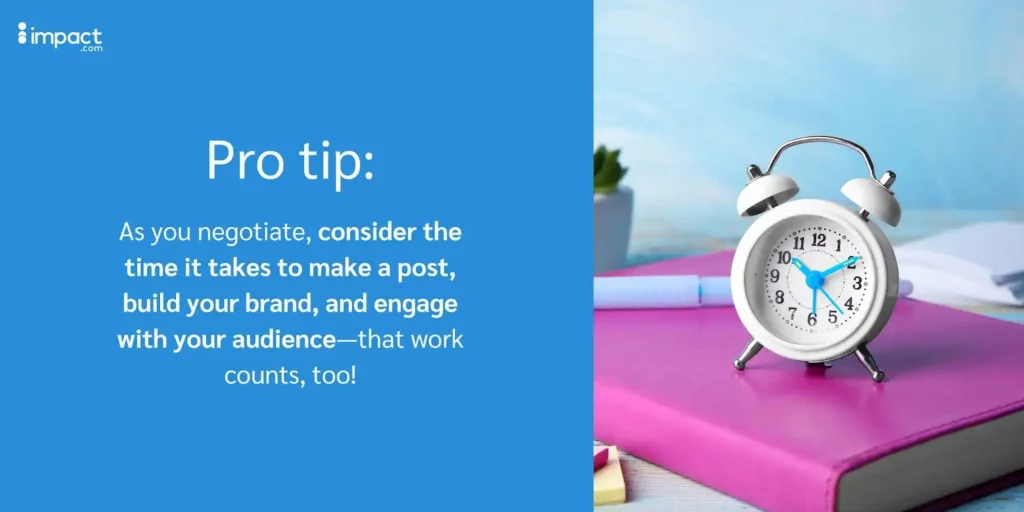
If it helps a brand feel more comfortable initially, you can also negotiate other forms of compensation, such as commission- or performance-based fees (e.g., 10 percent on every order you refer or $100 for every 1000 impressions). These hybrid deals can help maximize your income.
No matter what kind of compensation you and the brand decide, lock it in with a contract to keep everyone on the same page.
Finding fair rates is an experimentation process so don’t be hard on yourself if you under- or over-shoot. If it feels like you put in more work than the compensation accounts for, you know it’s time to bump up your rates.
5. Keep going after rejections
Rejection is inevitable, but it doesn’t reflect your worth. Keep going!
Re-frame rejections as a “maybe” for the future. A “no” can become a “yes” if the brand’s priorities change, they get more budget, or you grow your following.
Track your pitches with a spreadsheet, and try to understand a brand’s hesitations so you can reach out again.
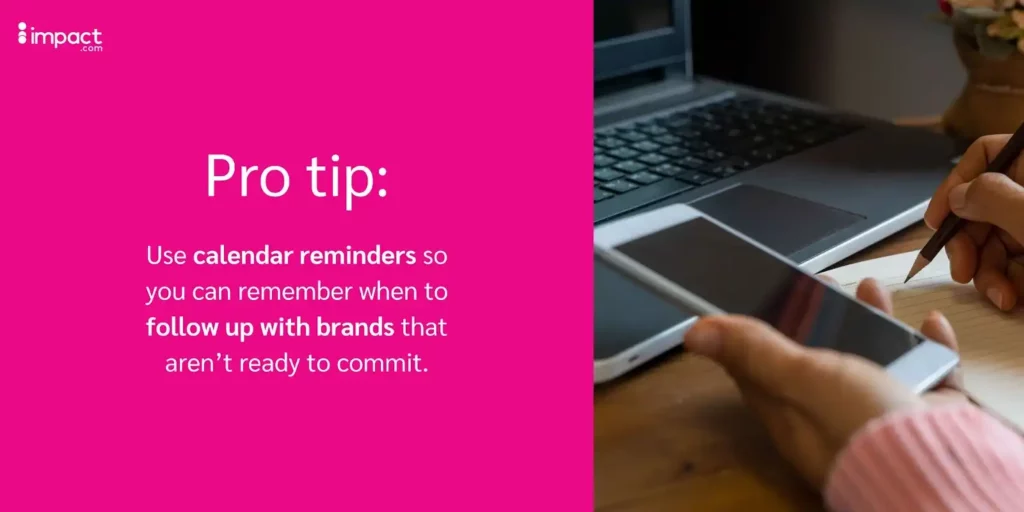
Make your brand deals a success
So you’ve landed your first brand deal. Congrats! Now what? Successful brand deals are key to sustaining brand relationships and building your portfolio.
- Prioritize driving results. Forty-two percent of brands will commit to long-term relationships with creators who help them achieve their campaign KPIs.
- Send post-campaign reports. Use metrics to help brands understand the results you drive and highlight successes in your media kit to help you land future brand deals.
- Keep the relationship going. Pitch fresh ideas based on how your audience responded. Or ask if the brand has any upcoming campaigns, sales, or product launches you can help with.
Remember, you’re not just a creator but a content entrepreneur. Hit the brand’s campaign goals out of the park to turn one-time deals into lasting partnerships.
Put yourself out there
Getting brand deals as a small influencer doesn’t have to be daunting. The best thing you can do is put yourself out there.
You’ll learn a lot along the way and can adjust your approach as you go.
Start by posting about and pitching brands you already use and love. Put together a media kit and tailor your pitch to each brand. As you grow your portfolio, reduce the risk for brands with commission- and performance-based compensation agreements.
As you gain confidence, you’ll find the pricing and pace of brand partnerships that work for you.
Ready to land brand deals? Sign up for impact.com / Creator to discover brands that want to hear from creators like you.
FAQs
There are several ways influencers of any size can find brands to work with:
-
- Reach out to brands whose products you already use
-
- Go after smaller brands. You’re less likely to be overlooked by larger brands with full inboxes.
-
- Seek out brands in adjacent niches. For example, if your niche is thrift shopping and you have a budget-conscious audience, you could partner with a budgeting app.
-
- Look at similar creators and see who they work with.
-
- Join a partnership platform like impact.com / Creator to find brands looking to expand their programs.
- Network by attending industry events and getting to know other influencers in your niche.
- Join online communities that serve both creators and brands (like the Buffer community on Discord).
Brands often prefer to work with micro- or nano-influencers over creators with more followers, so don’t sell yourself short! You could be exactly what a brand is looking for.
Start by warming up a connection with brands. Feature them in your posts, follow their pages, and like and comment on their posts. Let it feel genuine and authentic, not spammy.
Then, try to find the brand contact’s email address. You can use a site like Apollo.io or RocketReach.
You can also DM the brand on social media, find the brand contact on LinkedIn, or apply to their program through a partnerships platform like impact.com / Creator.
Then, reach out with a personalized pitch based on the brand’s target audience and products. Include your media kit and how you see the brand fitting with your audience and content.
As a small influencer, some brands will hesitate to pay for a traditional sponsorship. In these cases, get creative with your partnerships to reduce the brand’s risk.
Consider gifting and seed campaigns if you get other benefits from working with the brand, such as free product, exposure, or a known name for your brand kit.
Or work on a commission basis so the brand only pays for the sales you refer.
Finally, you can offer services that help a brand achieve goals outside of brand awareness, such as media creation for various marketing channels.
You can attract brands’ attention in a variety of ways:
-
- Make it easy for brands to find you. Add relevant descriptors to your social media profile and use any platform-specific SEO practices to make your content easy to discover.
-
- Post voluntary UGC and tag the brands you feature.
-
- Let brands know if you feature them somewhere untaggable, like your blog or newsletter.
-
- Engage with a brand’s content consistently to show your interest.
-
- Participate in a brand’s campaign hashtags.
-
- Attend a brand’s events.
-
- Create a distinct personal brand across platforms so potential partners can recognize you easily.
- Engage with the right brand contact on professional platforms like LinkedIn, Twitter, or in shared online communities.
